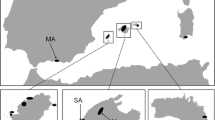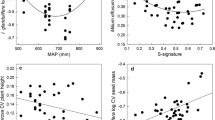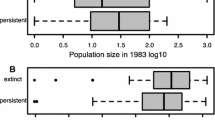Abstract
Plants inhabiting extreme environments may possess features allowing them to tolerate sudden abrupt changes in their environment, a phenomenon often known as ‘adaptability.’ However, ability or success in developing adaptability varies among plant populations. Adaptability can be quantified by measuring variation in the response to the same environmental challenges between plant populations. In this study, we evaluate the adaptability of the iconic Antarctic plant, Deschampsia antarctica, based on traits reflecting three levels of organization: the population level (S, D. antarctica land cover), individual level (Ph, biometrics), and cell level (relative DNA content, rcDNA, in cells of the leaf parenchyma). We sampled a total of six D. antarctica populations in the Admiralty Bay region, King George Island (South Shetland Islands, maritime Antarctic), during the austral summer of 2005–2006, and analyzed pairwise interrelations between various indices reflecting plant population adaptability. The results of these pairwise comparisons were then used to estimate a pooled measure of each population’s adaptability, designated as united latent quality indicator (ULQI). Our results demonstrated that the responses of individual adaptability indices were seldom synchronized, although one population from the central part of the Point Thomas oasis did show some degree of synchronicity. This population also demonstrated the highest ULQI, consistent with the relatively favorable microenvironmental conditions at this location. Two other populations located closer to the shoreline also demonstrated detectable synchronicity and moderate levels of ULQI, while the remaining populations revealed no synchronized responses and negative ULQI values. As the ULQI value obtained will be strongly influenced by the conditions experienced by any given population during a particular season, evaluation of population dynamics requires annual monitoring over multiple seasons.








Similar content being viewed by others
References
Aivazyan SA, Buchstaber VM, Yenyukov IS, Meshalkin LD (1989) Applied statistics. Classification and reduction of dimensionality. Finances and statistics, Moscow (in Russian)
Barcikowski A, Czaplewska J, Giełwanowska I, Loro P, Smykla J, Zarzycki K (2001) Deschampsia antarctica (Poaceae)—the only native grass from Antarctica. In: Frey L (ed) Studies on grasses in Poland. W. Szafer Institute of Botany, Polish Academy of Sciences, Kraków, pp 367–377
Barcikowski A, Czaplewska J, Loro P, Łyszkiewicz A, Smykla J, Wojciechowska A (2003) Ecological variability of Deschampsia antarctica in the area of Admiralty Bay (King George Island, maritime Antarctic). In: Frey L (ed) Problems of grass biology. W. Szafer Institute of Botany, Polish Academy of Sciences, Kraków, pp 393–407
Bauman EV, Moskalenko NE (2008) Methods of extremal grouping of the fractional parameters. Autom Remote Control 69:1955–1972
Beyer L, Bölter M (2002) Geoecology of Antarctic Icefree Coastal landscapes. Ecological studies 156. Springer, Berlin
Bölter M, Kappen L, Meyer M (1989) The influence of microclimatic conditions on potential photosynthesis of Usnea sphacelata: a model. Ecol Res 4:297–307
Causton DR, Venus JC (1981) The biometry of plant growth. Edward Arnold, London
Conrad M (1983) Adaptability, the significance of variability from molecule to ecosystem. Plenum Press, New York
Convey P (1996a) The influence of environmental characteristics on life history attributes of Anatarctic terrestrial biota. Biol Rev 71:191–225
Convey P (1996b) Reproduction of Antarctic vascular plants. Antarct Sci 8:127–134
Convey P (2011) Antarctic terrestrial biodiversity in a changing world. Polar Biol 34:1629–1641
Day AT, Ruhland CT, Xiong FS (2008) Warming increases aboveground plant biomass and C stock in vascular-plant-dominated Antarctic tundra. Glob Change Biol 14:1827–1843
Dietz H, Steinlein T (1996) Determination of plant species cover by means of image analysis. J Veg Sci 7:131–136
Edwards JA (1972) Studies in Colobanthus quitensis (Kunth) Bartl. and Deschampsia antarctica Desv.: V. Distribution, ecology and vegetative performance on Signy Island. Br Antarct Surv Bull 28:11–28
Finnigan JJ (2007) The turbulent wind in plant and forest canopies. In: Johnson EA, Miyanishi K (eds) Plant disturbance ecology, the process and the response. Academic Press, London, pp 15–58
Floyd DA, Anderson JE (1987) A comparison of three methods for estimating plant source. J Ecol 75:221–228
Fowbert JA, Smith RL (1994) Rapid population increases in native vascular plants in the Argentine Islands, Antarctic Peninsula. Arct Alp Res 26:290–296
Giełwanowska I (2005) Specific developmental characters of Antarctic vascular plants Colobanthus quitensis (Kunth) Bartl. and Deschampsia antarctica Desv. Dissertation, University of Warmia and Mazury, Olsztyn (in Polish)
Jong TJD, Klinkhamer PGL (1994) Plant size and reproductive success through female and male function. J Ecol 82:399–402
Kejna M (1999) Air temperature on King George Island, South Shetland Islands, Antarctica. Pol Polar Res 20:183–201
Kennedy KA, Addison PA (1987) Some considerations for the use of visual estimates of plant cover in biomonitoring. J Ecol 75:151–157
Kiernon JA (1990) Histological & histochemical methods. Theory and practice. Pergamon Press, New York
Kozeretska IA, Parnikoza IYu, Mustafa O, Tyschenko OV, Korsun SG, Convey P (2010) Development of Antarctic herb tundra vegetation near Arctowski station, King George Island. Polar Sci 3:254–261
Krywult M, Smykla J, Wincenciak A (2013) The presence of nitrates and the impact of ultraviolet radiation as factors that determine nitrate reductase activity and nitrogen concentrations in Deschampsia antarctica Desv. around penguin rookeries on King George Island, Maritime Antarctica. Water Air Soil Poll 224:1563
Krzewicka B, Smykla J (2004) The lichen genus Umbilicaria from the neighbourhood of Admiralty Bay (King George Island, maritime Antarctic), with a proposed new key to all Antarctic taxa. Polar Biol 28:15–25
Kunakh VA (2011) Zhebrak Readings. III. Ontogenetic plasticity of the genome as a basis of plant adaptation. Institute of Genetics and Cytology, NAS of Belarus. Pravo i Ekonomika, Minsk
Levin DA (2002) The role of chromosome changes in plant evolution. Oxford University Press, Oxford
Maarel E (2005) Vegetation ecology—an overview. In: Maarel E (ed) Vegetation ecology. Wiley, Malden, pp 1–51
Miryuta NYu, Kunakh VA (2011) Dynamic of cell population systems in vitro. 2. Temporal organization and robustness of Rauwolfia serpentina Benth. culture tissues system at passage level organization. Biotechnology (Ukraine) 4:16–29 (in Ukrainian)
Mosyakin SL, Bezusko LG, Mosyakin AS (2007) Origins of native vascular plants of Antarctica: comments from historical phytogeography viewpoint. Cytol Genet 41:54–63
Myers WL, Shelton RL (1980) Survey methods for ecosystem management. Wiley, New York
Ochyra R (1998) The moss flora of King George Island, Antarctica. W. Szafer Institute of Botany, Polish Academy of Sciences, Kraków
Parnikoza I, Maidanuk DN, Kozeretska IA (2007a) Are Deschampsia antarctica Desv. and Colobanthus quitensis (Kunth) Bartl. migratory relicts? Cytol Genet 41:36–40
Parnikoza IYu, Miryuta NYu, Maidanyuk DN, Loparev SA, Korsun SG, Budzanivska IG, Shevchenko TP, Polischuk VP, Кunakh VA, Kozeretska IA (2007b) Habitat and leaf cytogenetic characteristics of Deschampsia antarctica Desv. in maritime Antarctic. Polar Sci 1:121–127
Parnikoza IYu, Miryuta NYu, Al-Ammouri Yu, Kunakh VA (2008) Rauwolfia serpentina Benth. Cell populations dynamic in the context of different cultivation conditions in vitro. Biopolym Cell 24:300–309
Parnikoza I, Convey P, Dykyy I, Trokhymets V, Milinevsky G, Inozemtseva D, Kozeretska I (2009) Current status of the Antarctic herb tundra formation in the central Argentine Islands. Glob Change Biol 15:1685–1693
Parnikoza I, Kozeretska I, Kunakh V (2011a) Vascular plants of the maritime Antarctic: origin and adaptation. AJPS 2:381–395
Parnikoza IYu, Loro P, Miryuta NYu, Kunakh VA, Kozeretska IA (2011b) The influence of some environmental factors on cytological and biometric parameters and chlorophyll content of Deschampsia antarctica Desv in maritime Antarctic. Cytol Genet 45:170–176
Pollard JHP (1982) A handbook of numerical and statistical techniques. Finances and statistics, Moscow (in Russian)
Rakusa-Suszczewski S (1993) The maritime Antarctic Coastal ecosystem of Admiralty Bay. Department Antarctic Biological Polar Academical Sciences, Warsaw
Röttgermann M, Steinlein T, Beyschlag W, Dietz H (2000) Linear relationships between aboveground biomass and plant cover in low open herbaceous vegetation. J Veg Sci 11:145–148
Royles J, Amesbury MJ, Convey P, Griffiths H, Hodgson DA, Leng MJ, Charman DJ (2013) Plants and soil microbes respond to recent warming on the Antarctic Peninsula. Curr Biol 23:1702–1706
Smith RIL (1994) Vascular plants as indicators of regional warming in Antarctica. Oecologia 99:322–328
Smith RIL (2003) The enigma of Colobanthus quitensis and Deschampsia antarctica in Antarctica. In: Huiskes AHL, Gieskes WWC, Rozema J et al (eds) Antarctic biology in a global context. Backhuys, Leiden, pp 234–239
Strogonov BR (1973) Plant metabolism under salinization: materials of the XXXIII Timiryazev readings. Nauka, Moscow (in Russian)
Tchuraev RN (2006a) Genetal principles of organization and laws of functioning in governing gene networks. In: Kolchanov N, Hofesyaedt R (eds) Bioinformatics of genome regulation and structure. Springer, New York, pp 367–377
Tchuraev RN (2006b) Epigenetics: gene and epigene networks in the onto—phylogenesis. Genetica 42:1276–1296 (in Russian)
Tømmervik H, Wielgolaski FE, Neuvonen S, Solberg B, Høgda KA (2005) Biomass and production on a landscape level in the mountain birch forest. In: Wielgolaski FE (ed) Plant ecology, herbivory and human impact in Nordic Mountain Birch Forests. Series: Ecological studies, vol 180, Analysis and synthesis. Springer, Berlin, pp 53–70
Turner J, Colwell SR, Marshall GJ, Lachlan-Cope TA, Carleton AM, Jones PD, Lagun V, Reid PA, Iagovkina S (2005) Antarctic climate change during the last 50 years. Int J Climatol 25:279–294
Turner J, Barrand NE, Bracegirdle TJ, Convey P, Hodgson DA, Jarvis M, Jenkins M, Marshall G, Meredith MP, Roscoe H, Shanklin J, French J, Goosse H, Guglielmin M, Gutt J, Jacobs S, Kennicutt MC, Masson-Delmotte V, Mayewski P, Navarro F, Robinson S, Scambos T, Sparrow M, Summerhayes CP, Speer K, Klepikov A (2014) Antarctic climate change and the environment: an update. Polar Rec 50:237–259
Uchamanski J (2003) Ecology of individuals. In: Ambasht RS, Ambasht NK (eds) Modern trends in applied terrestrial ecology. Springer, Berlin, pp 247–274
Vera ML (2011) Colonization and demographic structure of Deschampsia antarctica and Colobanthus quitensis along an altitudinal gradient on Livingston Island, South Shetland Islands, Antarctica. Polar Res 30:7146
Weiner J, Thomas SC (1986) Size variability and competition in plant monocultures. Oikos 47:211–222
Wolf EB (1937) Polyploidy and geographic distribution of plants. Uspekhi Sovrem Biol 7:161–197 (in Russian)
Zwolska I, Rakusa-Suszczewski S (2002) Temperature as an environmental factor in the Arctowski station area (King George Island, South Shetland Islands). Glob Change 9:51–65
Acknowledgments
We express our gratitude to the National Antarctic Scientific Center of Ministry of the Education of Ukraine and Department of Antarctic Biology of Institute of Biochemistry and Biophysics Polish Academy of Science for assistance in this research. This study was carried out under a contract between the National Antarctic Scientific Center of the Ministry of Science and the Institute of Molecular Biology and Genetics (NAS of Ukraine), # H/3-2011 ‘Development of a Bioindicator System of Climate Change in Coastal Antarctica Based on the Dynamics of Terrestrial Plant Cenoses’ (2011–2012). This work was also supported by the agreement on scientific cooperation between the Polish Academy of Sciences and the National Academy of Sciences of Ukraine within the project ‘Adaptive strategy of mutual survival of organisms in extreme environmental conditions’ (2015–2017), and by the Polish Ministry of Science and Higher Education within the program ‘Supporting International Mobility of Scientists’ and Grant No. NN305376438. We also thank Dr. S. Rakusa-Suszczewski for organizing this expedition, Dr. A. Rozhok for helping with manuscript preparation, and anonymous referees for their constructive input. P. Convey is supported by NERC core funding to the British Antarctic Survey’s Ecosystems Program. This paper also contributes to the SCAR AnT-ERA program.
Author information
Authors and Affiliations
Corresponding author
Rights and permissions
About this article
Cite this article
Parnikoza, I., Miryuta, N., Ozheredova, I. et al. Comparative analysis of Deschampsia antarctica Desv. population adaptability in the natural environment of the Admiralty Bay region (King George Island, maritime Antarctic). Polar Biol 38, 1401–1411 (2015). https://doi.org/10.1007/s00300-015-1704-1
Received:
Revised:
Accepted:
Published:
Issue Date:
DOI: https://doi.org/10.1007/s00300-015-1704-1




